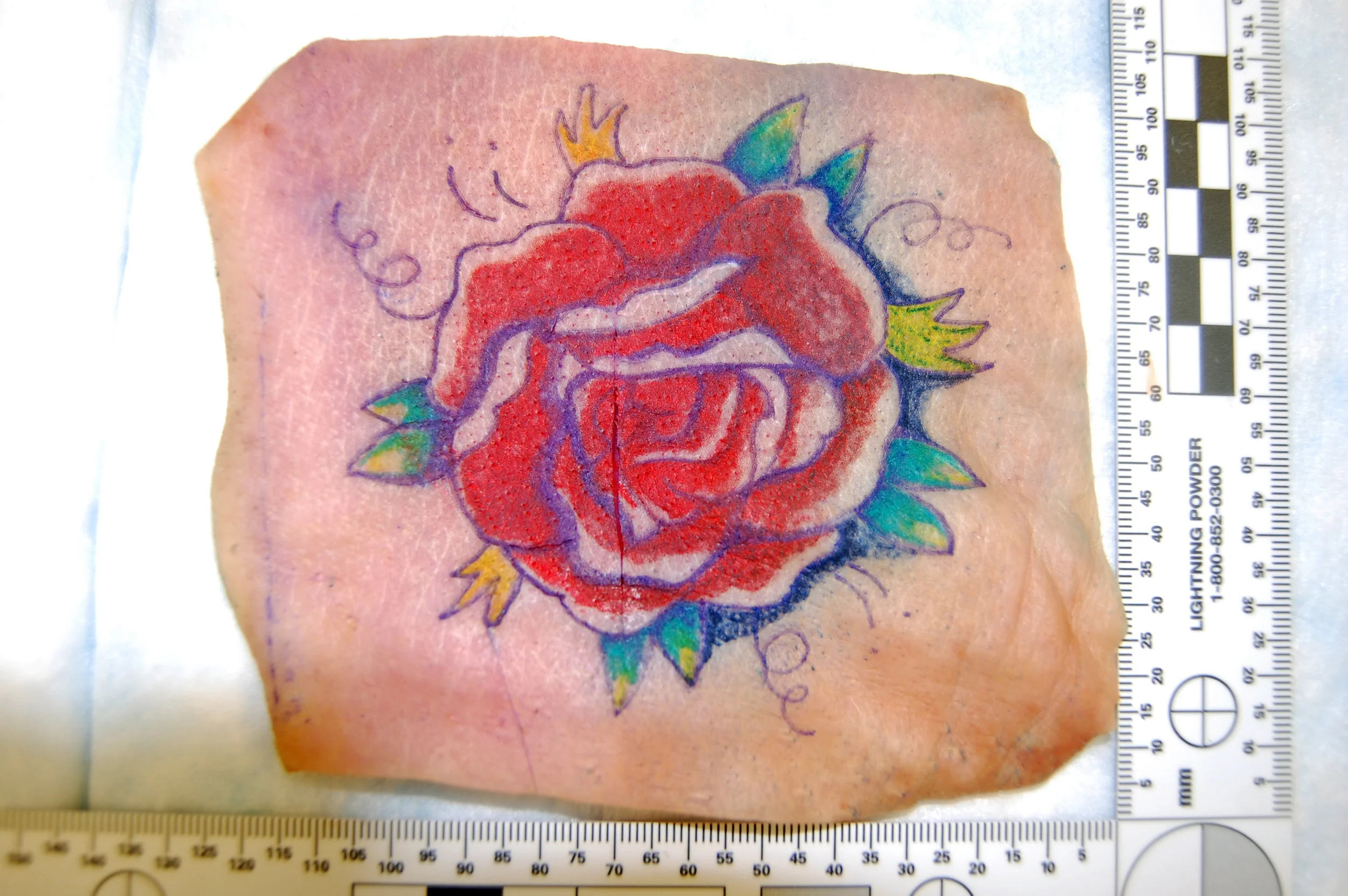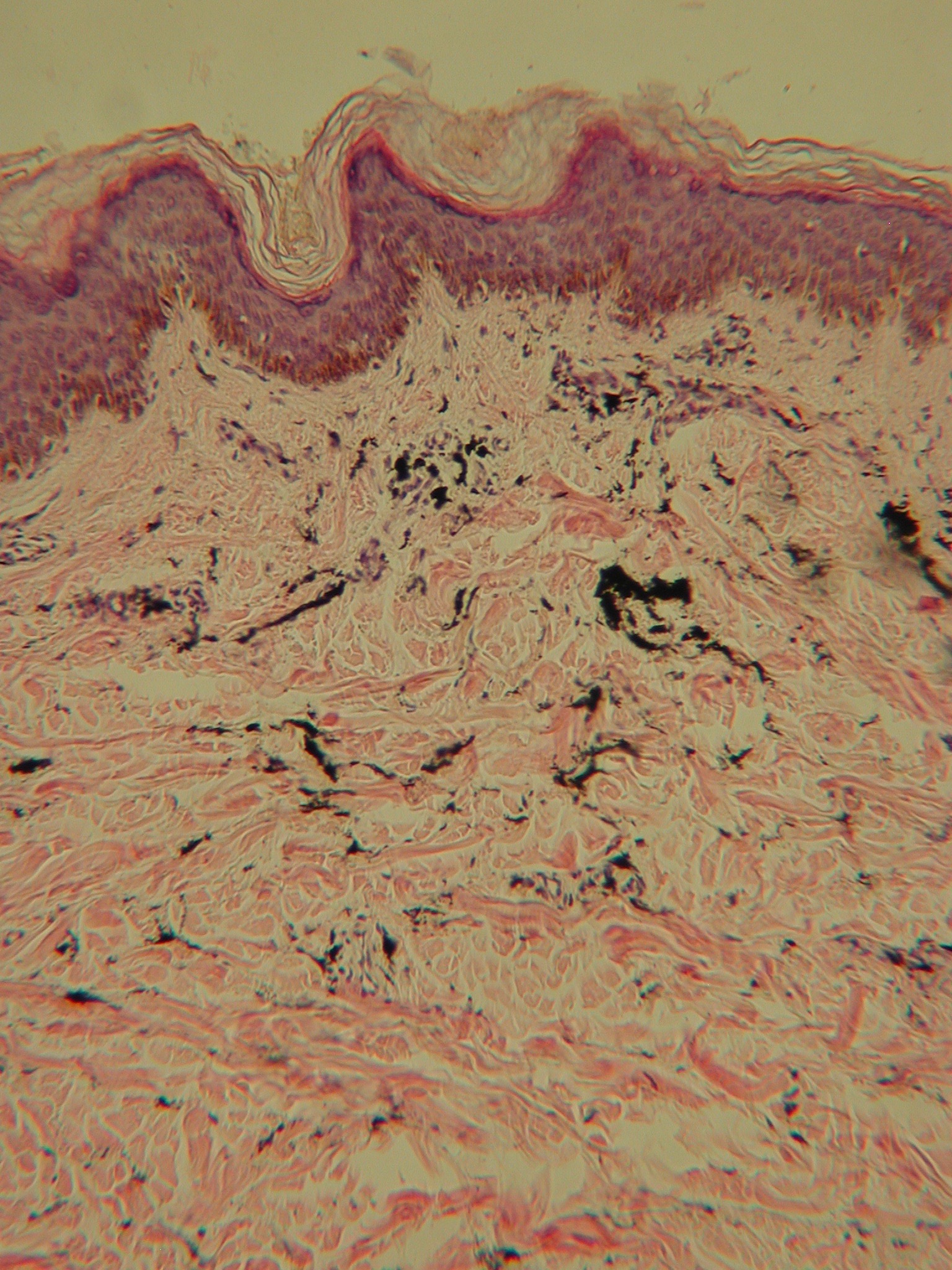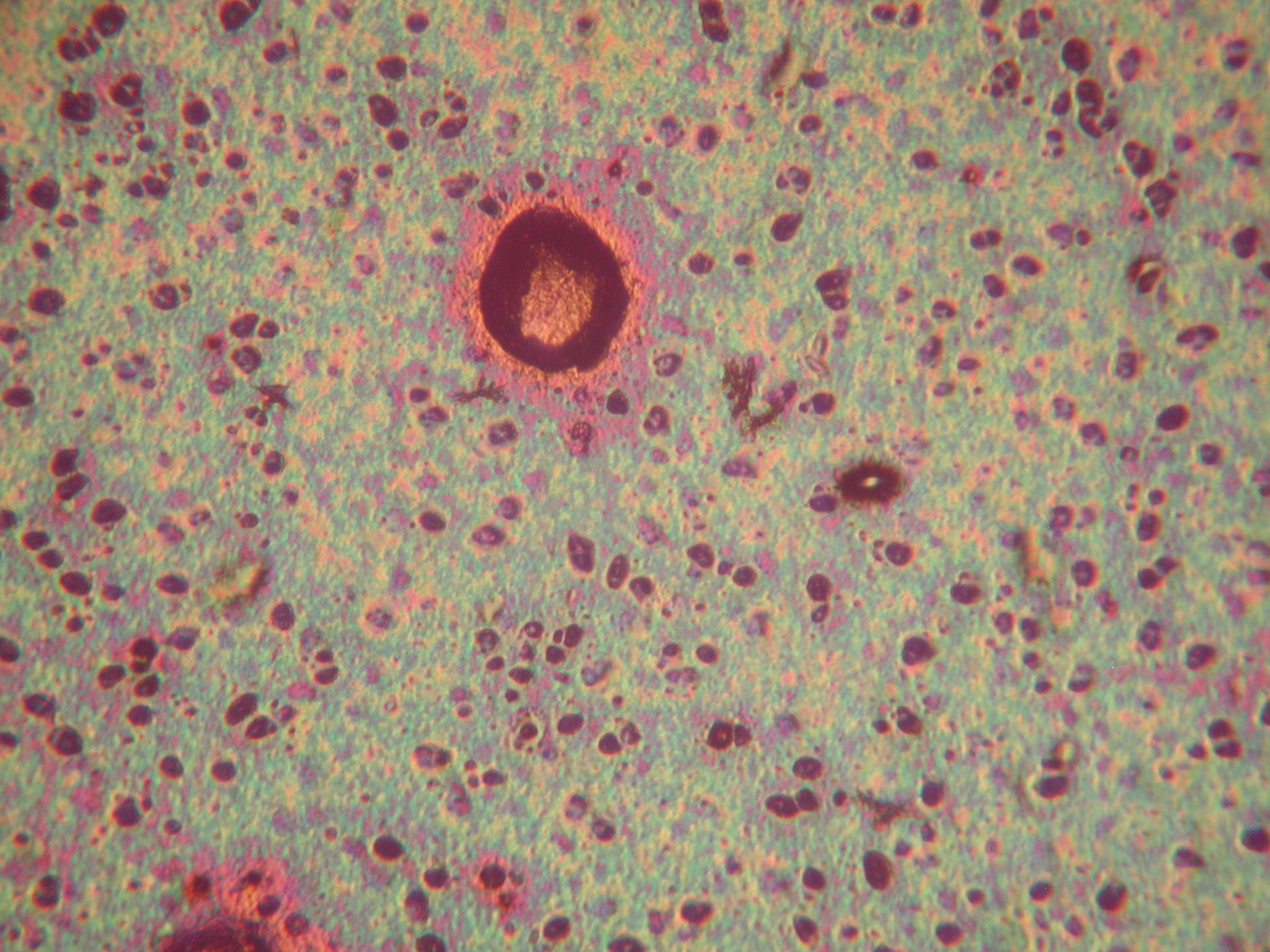Inkspector: The Forensic Analysis of Tattoos and Ink
If you’re planning on committing a murder anytime soon I have one piece of advice to help you evade capture: don’t get tattoos to commemorate the crime.
This might seem insultingly obvious, however, there’s a steady stream of news stories featuring culprits seeking to have their tattooed mementos excluded as evidence.
“The great thing about tattoos is that a simple visual examination can provide a wealth of information in a very short time frame. We can evaluate location, design, colors and any other physical feature right away, whether it is for the identification of remains or the identification of a suspect caught on film. One very interesting case is of a man who had tattooed a shooting scene on him. The individual’s tattoos were photographed during an unrelated arrest and a Detective recognized the tattoo design as corresponding to a homicide scene. This case certainly is not your average ‘crime scene investigation’ or ‘evidence analysis’ but it shows how tattoos can provide clues even in the most obscure ways.”
If a body is found at a crime scene, a death investigator is called. Their job is to apply forensic techniques to evaluate the circumstance of death, and to assist the pathologist with the autopsy.
“Death for most is a very sensitive topic. I always had a very clinical approach to the deceased; as if the body were a biological specimen with a story to tell.”
While working as a death investigator for the Rockland County medical examiner, Michelle Miranda had two specific cases that brought to her attention the dearth of scholarly information regarding the forensic analysis of tattoos and tattoo inks.
“A body, found burning in a park, made traditional identification methods such as facial features and fingerprints unsuitable. It was a tattoo that eventually led to a positive identification. The other investigation was a criminal case in which evaluation of the evidence presented questions as to whether or not a tattoo machine stained with tattoo ink had been used to make a hole in a garment where apparent ink residue was left behind.”
This lead her to become interested in the pivotal role tattoos can play in forensic science. Now an associate professor teaching an array of criminal justice related classes, Professor Michelle D. Miranda recently published Forensic Analysis of Tattoos and Ink, a pioneering book that attempts to fill the void of literature detailing the chemistry and analysis of tattoo inks and various ways tattoos can assist with criminal investigations.
Professor Miranda offers her time to explain the multifarious roles our tattoos, and tattoo inks, can take in forensic investigations.
How do you develop, ‘a clinical approach to the deceased’? And do you have any memorably grim moments?
It was probably because I was a science major in college and we had to take anatomy courses and dissect various types of remains. Many of the people I have worked with have the ability to disengage and think that way, although I have seen ‘seasoned’ individuals express emotions with certain cases (say, for example, a child) and it can take an emotional toll on individuals that have been in the field for long periods of time. Generally speaking, I prefer to remove emotions in order to approach investigations in an objective manner. I have seen, and smelled, some interesting cases. I can’t think of any that really tested my convictions or career choice, but some really make you think about the nature of man.
It makes you think what about the nature of man?
Well, it is readily apparent that people can do really horrible things to each other—even the average civilian not in the field of law enforcement/forensic investigations can watch or read the news and have an idea of the terrible things people do to one another. But news reports can be very different from actually being at a scene (or in some cases, just viewing the evidence and the crime scene photos). The general public does not see a lot of what really takes place. Even museum exhibits and photos shown in a courtroom can be toned down. Cases with children being harmed, tortured and/or killed really make you think about what people are capable of—there was the case of Nixzmary Brown, which occurred while I was at the crime lab. I remember the chair she was often tied to while tortured coming to the crime lab—such a simple object that became a symbol of violent abuse (the chair was submitted for trace evidence analysis and biological fluid analysis).
Another aspect that the general public may not think about often is what man can actually do to himself—suicide, drug overdoses, alcohol abuse, vehicle collisions from DWIs, texting while driving, or road rage, and people just forgotten and left to die because they couldn’t take care of themselves or were sick.
Some cases I’ve seen include: a suicide in which the man killed himself in a motel, organizing his belongings and even placing his identification in zip-lock bags so that the blood from the gunshot wound would not get all over them; a man on a motorcycle completely severed in half after driving erratically and being ejected from his motorcycle (each half of his body was located at different points on the side of the road—and his motorcycle kept traveling down the highway for a distance due to the speed); a teenage boy that left a suicide note blaming his mother for his suicide (this was tough on the investigator—do you show the note to his family?); a man so affected by alcohol that he was completely yellow and every drawer, his closet and under his bed was filled with empty bottles of vodka, which he was hiding from his family; two people that attempted suicide by jumping off of a bridge together—one survived, the other did not; murder-suicide of wife and husband (by husband); poisoning of a woman by her soon-to-be ex-husband.
I have also gotten to see some interesting tattoos that were quite memorable. Like a man that had ‘25c’ and a slot tattooed on his penis, or a very obese man with a tattoo of cherry pie and ‘I Love Pie’ around it.
Tattoo inks in pigskin.
That’s heavy. Can you tell us about your book Forensic Analysis of Tattoos and Inks?
The book covers the historical evolution of tattooing and tattoo inks, including the evolution of tattoo ink chemistry. The book starts by introducing the reader to the process of tattooing and also addresses the interaction of tattoo ink with human tissue. A portion of the book covers tattoos and their role in criminal and forensic investigations as well as the role tattoos have played in court cases. The second half of the book deals in detail with the scientific examination of inks in order to evaluate the types of pigments present in various tattoo inks.
Overall, from an initial examination on the tattoo, whether on a living or deceased individual, investigators should learn to recognize types, styles, and patterns of tattoos that may lend themselves to describing the wearer’s affiliations or associations. In addition, investigators should have some idea of local tattoo artists and their styles in cases where they’re trying to link a certain tattoo to an artist in an effort to try and identify the wearer. Investigators should also understand what forensic experts and crime labs are capable of doing to resolve and evaluate tattoos and tattoo inks, including the use of photographic techniques and alternate light sources as well as microscopy and spectroscopy. Understanding the evolution of tattoo inks as well as the persistence of tattoo inks and designs is also important and should be considered by the investigator.
So, at what point do tattoos become essential to identifying victims?
Criminals may cut off hands, feet or heads to prevent identification; they may also bury, dump or otherwise try to destroy evidence of the crime by preventing the identification of the remains (burning, dumping in water, etc.). Tattoos are persistent; and are rapid means of identification. And traditional databases, such as those for fingerprints, DNA profiles and dental records are limited—if the victim or suspect does not have a profile on file, these methods may not provide any information. But an individual’s tattoos are often displayed and viewed by many, whether by family members, friends, coworkers, and of course the tattoo artist.
Tattoos on living individuals can also prove useful, as tattoos may serve as an integral part of eyewitness reports or may be recorded by photography or videography during the commission of a crime. With regard to the chemical composition of tattoo inks, chemical information can aid in determining the age, quality or prevalence of the ink.
Can you explain how scientific inquiry is applied to the chemistry of tattoo ink?
With respect to tattoo ink chemistry, knowledge about the chemical composition can aid in the dating of the tattoo, since tattoo inks have varied their composition over time. In the book I trace the evolution of tattoo ink composition and its change from ancient times (where inks were largely limited to carbon based black colors) to the introduction of ink colors (which contained inorganic pigments containing iron, chromium, zinc, mercury, etc.) to present day inks (which contain organic pigments).
What this could be able to do is provide information regarding the age of the individual with the tattoo, which would be a tool for identifying the individual. The classes of pigments include carbon based (think ancient, tribal inks), natural (minerals, inorganic) and synthetic (organic). The tattoos from the mid to late 1900’s have a high concentration of heavy metals. These would be part of the natural minerals class. In the 20th and into the 21st century, we transitioned to the synthetic organic (which is what we use today).
Think about when you have seen a tattoo on an old timer, usually these appear blurry, the colors are mostly black (which appears blue), green and red. These are characteristic of those tattoos of the late 1900’s. Most people with knowledge of tattoos can tell the difference between those tattoos (think old servicemen tattoos made popular by Sailor Jerry, tattoo artists on the Bowery in NY, George Burchett, etc.) and the tattoos of today (finer lines, more colors, brighter colors). So lets say we find human remains – information about the inks as well as the design can help provide an age to the tattoo and thus an age to the wearer. This can lead to identification. Here is a comparison:
The left and middle tattoos were obtained in the mid 1900’s. The tattoo on the right was obtained in the early 2000’s. Note the differences in design and color – chemical analysis is going to tell us these tattoos differ in date obtained. This lends itself to determining an age range of our individual, which can lead to determining identity.
And how can the optics of a tattoo lead to a positive identification?
If the tattoo has enough characteristics and can be traced to one particular individual, then that can provide the information to guide an investigation, specifically in the search for the perpetrator.
For example, in the Bronx teens stumbled upon the body of a female dumped in the woods. It was photographs of her tattoo that identified her. This investigatory information led to her husband, and information concerning the timeline of: filing for divorce, the application of a restraining order, a history of abuse, and ultimately the disappearance of the victim. The tattoo was simply an ankle tattoo of a starburst. This case demonstrates the power of even a small, simple tattoo to lend itself to a rapid identification and location of a suspect.
Could you provide several case examples where the forensic analysis of tattoos has led to identification?
From victim identification like the case I mentioned earlier to the crime scene tattooed on the suspect’s chest, tattoos are a wealth of information. Some other cases I refer to in the book as well as during lectures are:
A case in New York City where a man claimed to have been assaulted by a police officer, asserting that the officer used his retractable baton to perforate the man’s underwear and penetrate his rectum. Microscopic examination of the damaged fibers at the periphery of the hole in the man’s underwear disclosed the presence of dark staining. Subsequent isolation and spectroscopic analysis of the stained regions established the presence of organic compounds that are found in tattoo ink.
Then there was a case evaluating the tattoos of former American football player Aaron Hernandez. Here, lawyers believed the tattoos placed on the athlete during his travels have corresponded to murders he was suspected of being involved in. The lawyers wanted to locate the artists that may have tattooed him in an effort to determine where he was located during certain time periods.
More recently, individuals that do not traditionally get tattooed due to religious or moral beliefs are opting for tattoos to aid in their identification should they become a victim of terrorism or a war crime. This is interesting considering these individuals have to make a choice to like this in the wake of widespread fears of terrorism.
And then there’s the abundance of unsolved cases in which the tattoo is the primary evidence presented to the public in an effort to identify the individual.
So judging by the importance of tattoos when they appear in criminal investigations, how come nothing like this has been written before and what procedures were investigators following prior to your book?
I don’t know. If I were to guess, I would say that since the identification and investigation is often the duty of law enforcement/police, scientific experts in the field of forensic science have not weighed in very much. I’m not sure if there were any standard procedures—typically a photograph is taken and disseminated to the public in the hopes that someone recognizes the design and can put a name to the tattoo. As for analysis of tattoo inks, whether from the bottle or human tissue, it just doesn’t to seem to have played a significant role in forensic investigations. I am hoping that the book will provide awareness of the capabilities of tattoos as well of the inks and thus play a greater role in forensic investigations and identification.
Purchase Forensic Analysis of Tattoos and Tattoo Ink
Follow Forensic Tattoo on Instagram for your daily dose of death












